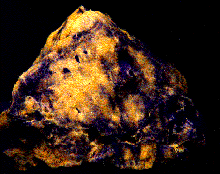
|
|||||
|
|
|||||
|
|
|
Luminescence / Fluorescence
06.21.00: Luminescence is a collective term for the different ways in which a substance emits visible light under the influence of certain rays, with the exception of pure heat radiation. Of special interest to the mineral collector is luminescence in ultraviolet colors of the spectrum. The concept of fluoresence originated from the mineral fluorite, because it was in this mineral that this phenomenon of omitting light was recognized for the first time. If the substance carries on omitting light when the radiation ceases we speak of phosphorescence, named after the well-known optical property of phosphorus. The causes of fluorescence are certain disruptive factors (impurities or structure defects) in the crystal lattice. Most minerals respond to short-wave UV (254 nanometres). There are minerals which react exclusively to shortwave UV, others which react only to long-wave (366 nanometres) and others again which react to both short-wave and long-wave. Members of one mineral family can fluorensce in quite different colors, while others of the same mineral type do not light up at all under UV. Occasionally fluorescence may help determine where a mineral came from, if it shows characteristics which are typical of a locality or deposit. Fluorescence has also proven itself as a valuable aid in diagnosing gemstones, particularly in identifying synthetic stones.. The appearance of luminescence under x-rays makes it possible to distinguish genuine pearls from cultivated pearls. Mother-of-pearl in saltwater pearls does not luminesce, but that of freshwater pearls lights up brightly. Since the artifical nucleus of the cultivated pearls is made up of freshwater mother-of-pearl, cultivated pearls will show luminescence, in contrast to genuine pearls. While Some Minerals Are Known To Fluoresce, Others May Not Longwave UV (at 365 nanometers) lies in the UV-A part of the light spectrum. You can buy blacklight lightbulbs in stores, in case you want to try this out at home. Shortwave UV, on the other hand, lies in the UV-B part of the spectrum and encompasses rays that can cause sunburn, so you're not going to find shortwave lightbulbs in the stores. When a fluorescent lamp is lit, never look at the light source for it can permanently damage the eyes. In addition, skin should not be prolongly exposed to the light as it can cause sunburns. Check this site for information on UV lamps: http://www.minresco.com/uvp/uvp.htm Though some minerals are known to fluoresce, samples from the same specimen may fail to fluoresce consistently. Only some fluorite (from which the term 'fluoresence' is derived) will glow an eerie blue. (It's thought that the inclusion of organic materials or rare earth ions in the crystal structure is the cause of its fluorescence.) Willemite from Franklin, New Jersey, almost always fluoresces (because it contains manganese), but willemite from other localities will not. Here's a list of minerals known to fluoresce and the colors they show: Scheelite - bluish white under shortwave. Fluorite - blue under longwave. Scapolite - orange-yellow under longwave. Willemite - specimens from Franklin, NJ, usually fluoresce bright green under shortwave. Calcite - some varieties fluoresce red, yellow, pink or blue. Autunite - yellow green. Hyalite - (a variety of opal), yellow or green. Diamond Eucryptite Fluorescence is usually noted only as an interesting mineral property, since the same mineral type may fluoresce different colors or may not fluoresce at all, it is therefore not a reliable method for mineral identification. Once a mineral has been identified, its fluorescent color can be used to identify its place of origin. Similarly, if a mineral from a certain locality glows a specific color and one has a mineral from that locality glowing that color, the mineral can be identified. Color and intensity of the glow can vary among specimens of a particular mineral. However, specimens from the same locality always fluoresce in the same color. Calcite may fluoresce red, orange, yellow, white, green, etc., but is always red at Franklin, New Jersey, and bluish-white at Terlingua, Texas. Phosphorescence is a phenomenon exhibited in a few fluorescent minerals where the mineral continues to glow after the UV light source has been removed. The glow fades after a few seconds. Only few minerals phosphoresce and it is only noted as an interesting mineral property. Certain mineral specimens from specific localities all phosphoresce. Foe example, calcite specimens from Terlingua, Texas fluoresce bluish-white with a strong phosphorescence.
|
|||
|
|
|||||
